Refer to the exhibit.

The static route is not present in the routing table of an adjacent OSPF neighbor router. Which action resolves the issue?


Refer to the exhibit SW100 cannot receive routes from R1 Which configuration resolves the issue?


What are the two prerequisites to enable BFD on Cisco routers? (Choose two)
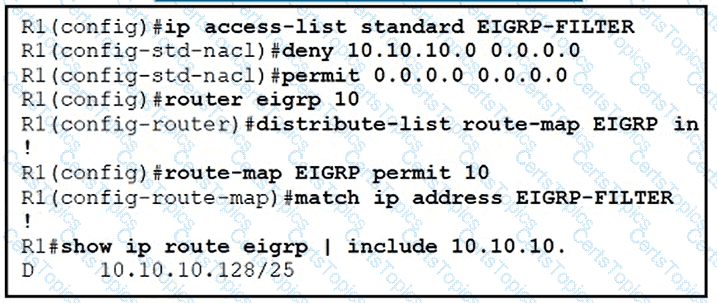
Refer to lhe exhibit An engineer must filter EIGRP updates that are received to block all 10 10 10.0/24 prefixes The engineer tests the distribute list and finds one associated prefix. Which action resolves the issue?
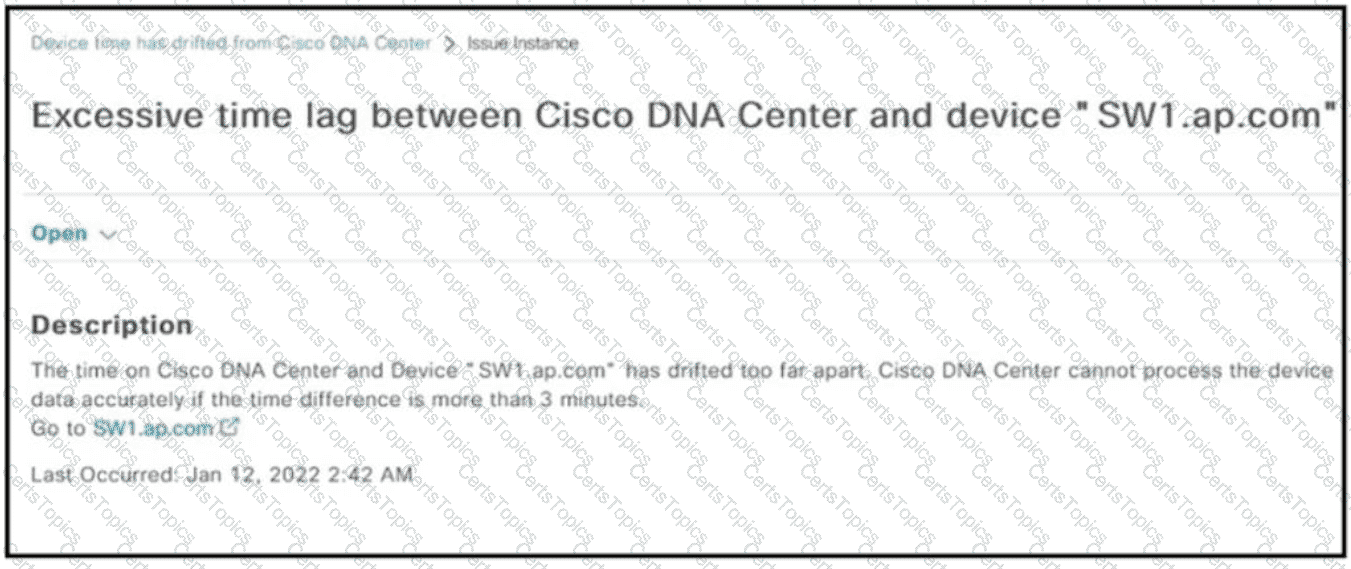
Refer to the exhibit. Which action resolves the issue?

Refer to the exhibit. An engineer is troubleshooting suboptimal communication from the 192.168.5.32/28 subnet to the 172.16.3.16/28 segment using the slowest links. Which configuration resolves the suboptimal routing issue?

Refer to the exhibit. An engineer cannot determine the time of the problem on R1 due to a mismatch between the router local clock and legs. Which command synchronizes the time between new log entries and the local clock on R1?
Refer to the exhibit.

During ISP router maintenance, the network produced many alerts because of the flapping interface. Which configuration on R1 resolves the issue?
Which Layer 3 VPN attribute allows different customers to connect to the same MPLS network with overlapping IP ranges?

Refer to the exhibit.
A shoe retail company implemented the uRPF solution for an antispoofing attack. A network engineer received the call that the branch A server is under an IP spoofing attack. Which configuration must be implemented to resolve the attack?
A)

B)

C)

D)


Refer to the exhibit An engineer observes that every time the ICMP packet is lost at a polling interval, track 1 goes down, which causes unnecessary disruption and instability in the network. The engineer does not want the traffic to be rerouted if the loss of ICMP packets is negligible. If the packet loss is persistent for a longer duration, the track must go down and the traffic must be rerouted. Which action resolves the issue?

Refer to the exhibit. Which configuration advertises more specific routes to R1 without sending a BGP summary route?
Refer to the exhibit.

A network engineer finds that PC1 is accessing the hotel website to do the booking but fails to make payment. Which action resolves the issue?
Refer to the exhibit.

A prefix list is created to filter routes inbound to an EIGRP process except for network 10 prefixes After the prefix list is applied no network 10 prefixes are visible in the routing table from EIGRP. Which configuration resolves the issue?
Refer to the exhibit. The ISP router is fully configured for customer A and customer B using the VRF-Lite feature. What is the minimum configuration required for customer A to communicate between routers A1 and A2?


Refer to the exhibit. An administrator wanted to make R1 always elected as DR. R2 as BDR. and R3 as DROTHER but could not achieve the desired results. Which two configurations resolve the issue? (Choose two.)
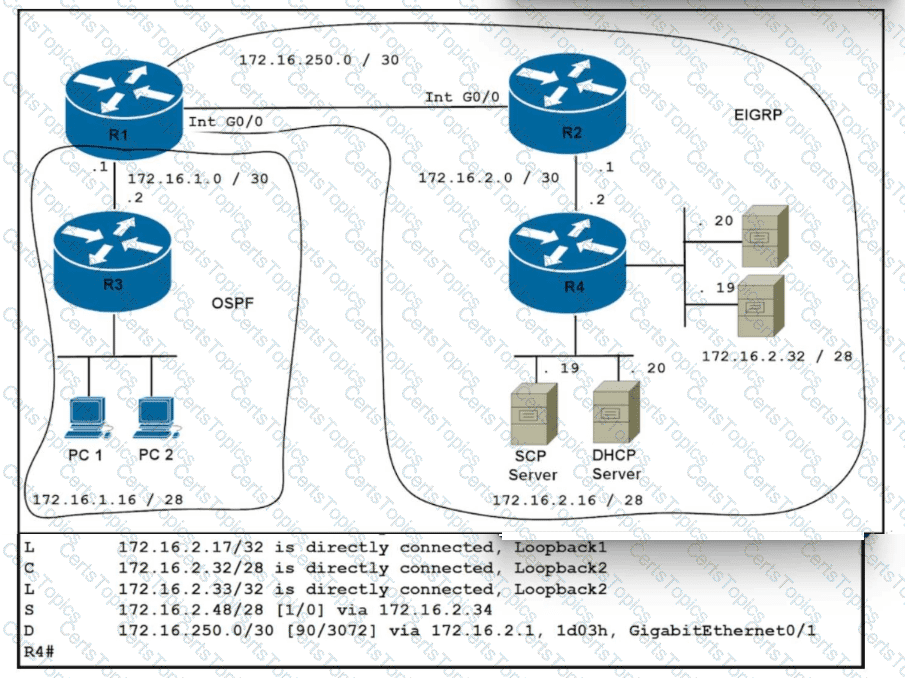
Refer to the exhibit. The users from subnet 172.16.1.16/28 are experiencing connectivity issues to subnet 172.16.2.32/48. Which configuration resolves the issue?
Refer to the exhibit.

R4 is experiencing packet drop when trying to reach 172.16.2.7 behind R2. Which action resolves the issue?

Refer to the exhibit. Users are experiencing slow response times from critical application servers connected to the network. The engineer determined from the console log that there is a DOS attack on the interface GigabitEthernet0/0. Which action must the engineer take to resolve the issue?
An engineer received a ticket about a router that has reloaded. The monitoring system graphs show different traffic patterns between logical and physical interfaces when the router is rebooted. Which action resolves the issue?

Refer to the exhibit. An engineer must troubleshoot a connectivity issue impacting the redistribution of the subnet 172.16.2.48/28 into the OSPF domain. Which configuration on router R1 advertises this subnet into the OSPF domain?


Refer to the exhibit A network engineer notices that the configured track option is down Which configuration resolves the issue*?
A company Is redesigning WAN infrastructure so that all branch sites must communicate via the head office and the head office can directly communicate with each site independently. The network engineer must configure the head office router by considering zero-touch technology when adding new sites in the same WAN infrastructure. Which configuration must be applied to the head office router to meet this requirement?

An administrator attempts to download the pack NBAR2 file using TFTP from the CPE router to another device over the Gi0/0 interface. The CPE is configured as below:

The transfer fails. Which action resolves the issue?


Refer to the exhibit. A customer finds that traffic from the application server (192.168.1.1) to the HUB site passes through a congested path that causes random packet drops. The NOC team influences the BGP path with MED on RB. but RD still sees that traffic coming from RA is not taking an alternate route. Which configuration resolves the issue?
A)

B)

C)

D)

Which method provides failure detection in BFD?


Refer to the exhibit. An engineer implemented an access list on R1 to allow anyone to Telnet except R2 Loopback0 to R1 Loopback4 How must sequence 20 be replaced on the R1 access list to resolve the issue?
Refer to the exhibit.
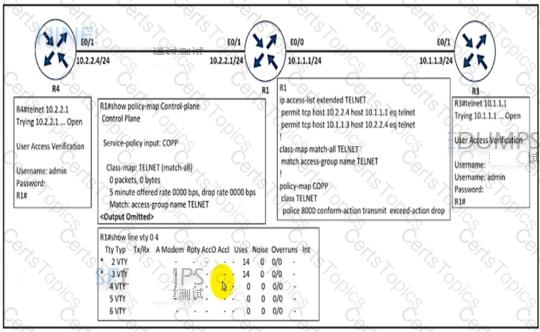
An engineer implemented CoPP to limit Telnet traffic to protect the router CPU. It was noticed that the Telnet traffic did not pass through CoPP Which configuration resolves the issue?
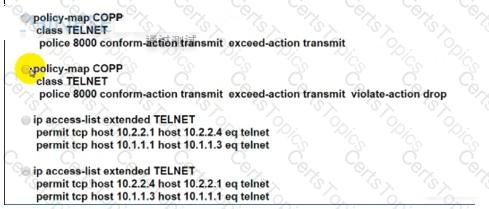
Refer to the exhibit.

Which set of commands restore reachability to loopback0?
A)

B)

C)

D)

Users report issues with reachability between areas as soon as an engineer configured summary routes between areas in a multiple area OSPF autonomous system. Which action resolves the issue?
Refer to the exhibit.

R1 test its directly connected EIGRP peer 172.16.33.2 (SW1). Which configuration resolves the issue1?
Refer to the exhibit.

An engineer configures two ASBRs 10 4 17.6 and 10 4 15 5 in an OSPF network to redistribute routes from EIGRP However, both ASBRs show the EIGRP routes as equal costs even though the next-hop router 10 4 17 6 is closer to R1 How should the network traffic to the EIGRP prefixes be sent via 10 4.17.6?
A customer reports that traffic is not passing on an EIGRP enabled multipoint interface on a router configured as below:
interface Serial0/0
no ip address
interface Server0/0/0.9 multipoint
ip address 10.1.1.1 255.255.255.248
ip split-horizon eigrp 1
Which action resolves the issue?

Refer to the exhibit. The engineer is getting an error when trying to transfer a new IOS file to the router. Which action resolves the issue?
:579

Refer to the exhibit. Router ABR-Rtr is not propagating the internet routes in OSPF area 10. which causes internet reachability problems in the area. Which action resolves the issue?

Refer to the exhibit A company builds WAN infrastructure between the head office and POPs using DMVPN hub-and-spoke topology to provide end-to-end communication All POPs must maintain point-to-point connectivity with the head office Which configuration meets the requirement at routers R12 and R13?


Refer to the exhibit.

Which configuration enables OSPF for area 0 interfaces to adjacency with a neighboring router with the same VRF?
Refer to the exhibit.

The security department recently installed a monitoring device between routers R3 and R5, which a loss of network connectivity for users connected to R5. Troubleshooting revealed that the monitoring device cannot forward multicast packets. The team already updated R5 with the correct configuration. Which configuration must be implemented on R3 to resolve the problem by ensuring R3 as the DR for the R3-R5 segment?
A)

B)

C)

D)


Refer to the exhibit R1 cannot establish a neighbor relationship with R2 Which action resolves the issue"?
Refer to the exhibit.

R1 has a route map configured, which results in a loss of partial IPv6 prefixes for the BGP neighbor, resulting in service degradation. How can the full service be restored?

Refer to the exhibit. R10 attempts to copy an image file from R11 using TFTP, and the operation is timing out. Which action resolves the issue?
A network engineer must configure a DMVPN network so that a spoke establishes a direct path to another spoke if the two must send traffic to each other. A spoke must send traffic directly to the hub if required Which configuration meets this requirement?


The network administrator configured the router for Control Plane Policing to limit OSPF traffic to be
policed to 1 Mbps. Any traffic that exceeds this limit must also be allowed at this point for traffic
analysis. The router configuration is:
access-list 100 permit ospf any any
!
class-map CM-OSPF
match access-group 100
!
policy-map PM-COPP
class CM-OSPF
police 1000000 conform-action transmit
!
control-plane
service-policy output PM-COPP
The Control Plane Policing failed to monitor and police OSPF traffic. Which configuration resolves this
issue?

An engineer is creating a policy that overrides normal routing behavior.if the route to a destination of
10.100.100.0/24 is withdrawn from the routing
Table, the policy must direct traffic to a next hop of 10.1 1.1. if the route is present in the routing table, then
normal forwarding must occur. Which
configuration meets the requirements?
Refer to the exhibit.

An engineer must configure a LAN-to-LAN IPsec VPN between R1 and the remote router. Which IPsec
Phase 1 configuration must the engineer use for the local router?

Refer to the exhibit The SNMP server with IP address 172.16 4 4 cannot access host router A Which configuration command on router A resolves the issue?
Refer to the exhibit.

An engineer configured BGP and wants to select the path from 10.77.255.57 as the best path instead
of current best path. Which action resolves the issue?

Refer to the exhibit An engineer must connect the Reno and Detroit spokes using DMVPN phase 2 Hub tunnel configuration is

Which configuration accomplishes the task?




Refer to the exhibit.

An engineer implemented CoPP but did not see OSPF traffic going through it. Which configuration resolves the issue?
Refer to the exhibit.

A network administrator notices these console messages from host 10.11.110.12 originating from interface E1/0. The administrator considers this an unauthorized attempt to access SNMP on R1. Which action prevents the attempts to reach R1 E1/0?
An engineer must establish a connection between two CE routers for two customers with overlapping IP addresses Customer_a is connected to interfaces Gig0/0, and Customer_b is connected to interfaces Gig0/1. Routers CE1 and CE2 are configured as follows:

Drag and drop the code snippets from the right onto the boxes in the configuration to establish the needed connection. Snippets may be used more than once.

Refer to the exhibit.


AS111 is receiving its own routes from AS200 causing a loop in the network. Which configuration provides loop prevention?
A)

B)

C)

D)



Refer to the exhibit. An engineer must troubleshoot a connectivity issue impacting the redistribution of the subnet 172.16.2.48/28 into the OSPF domain. Which configuration on router R1 advertises this subnet into OSPF?
Refer to the exhibit.

An administrator is configuring a GRE tunnel to establish an EIGRP neighbor to a remote router. The other tunnel endpoint is already configured. After applying the configuration as shown, the tunnel started flapping. Which action resolves the issue?
Refer to the exhibit.

The none area 0 routers in OSPF still receive more specific routes of 10.1.1.0.10.1.2.0.10.1.3.0 from area 0. Which action resolves the issue?


Refer to the exhibit. An engineer Is troubleshooting a routing loop on the network to reach the 172.16.3.0/16 from the OSPF domain. Which configuration on router R1 resolves the Issue?
A)

B)

C)

D)



Refer to the exhibit. A customer reports a failure and intermittent disconnection between two office buildings, site X and site Y. The network team determines that both sites are exchanging email application traffic with the data center network. Which configuration resolves the issue between site X and site Y?
A newly installed spoke router is configured for DMVPN with the ip mtu 1400 command. Which configuration allows the spoke to use fragmentation with the maximum negotiated TCP MTU over GRE?

Refer to the exhibit. The default route is not advertised to the neighboring router. Which action resolves the issue?
Refer to the exhibit.

An engineer has configured policy-based routing and applied the configured to the correct interface. How is the configuration applied to the traffic that matches the access list?
Which technique removes the outermost label of an MPLS-tagged packet before the packet is forwarded to an adjacent LER?
Which MPLS value is combined with the IP prefix to convert to a VPNv4 prefix?
An engineer is implementing a coordinated change with a server team. As part of the change, the engineer must configure interlace GigabitEthernet2 in an existing VRF "RED" then move theinterface to an existing VRF "BLUE" when the server team is ready. The engineer configured interface GigabitEthemet2 in VRF "RED"

Which configuration completes the change?
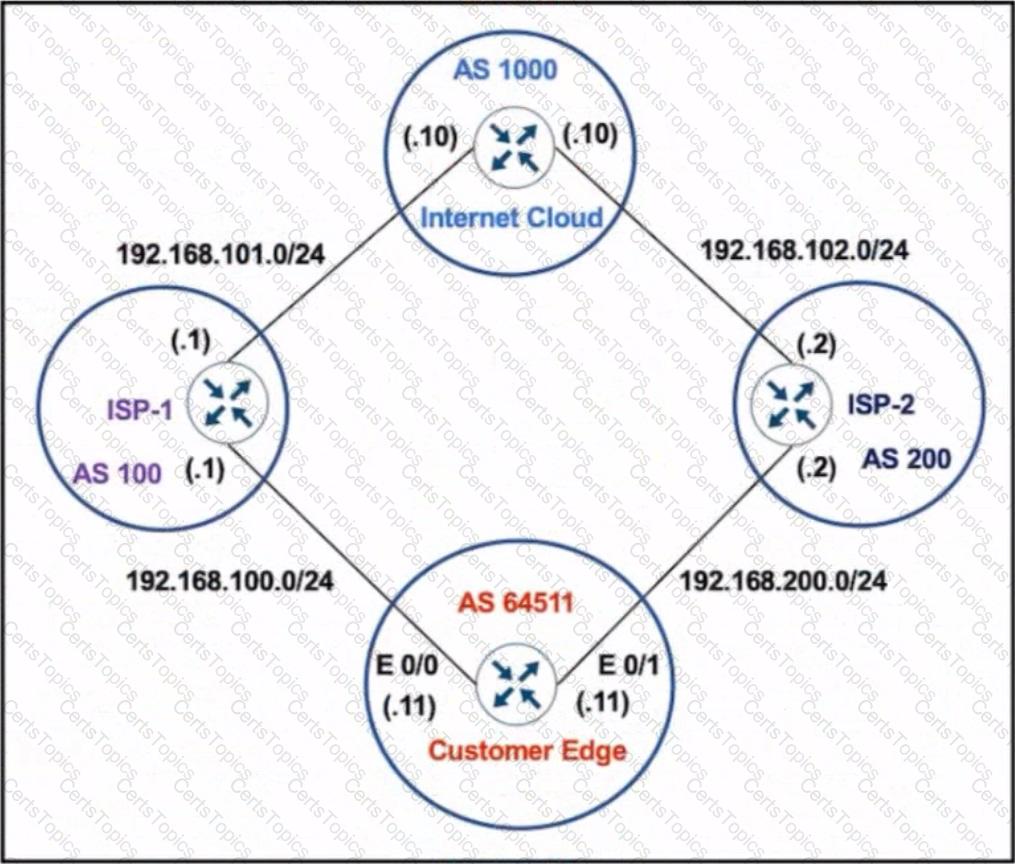
Refer to the exhibit. The network administrator has configured the Customer Edge router (AS 64511) to send only summarized routes toward ISP-1 (AS 100) and ISP-2 (AS 200).
router bgp 64511
network 172.16.20.0 mask 255.255.255.0
network 172.16.21.0 mask 255.255.255.0
network 172.16.22.0 mask 255.255.255.0
network 172.16.23.0 mask 255.255.255.0
aggregate-address 172.16.20.0 255.255.252.0
After this configuration. ISP-1 and ISP-2 continue to receive the specific routes and the summary route. Which configuration resolves the issue?
What are two MPLS label characteristics? (Choose two.)
Refer to the exhibit.

R1 is being monitored using SNMP and monitoring devices are getting only partial information. What action should be taken to resolve this issue?
Refer to Exhibit.

The network administrator configured the branch router for IPv6 on the E0/0 interface. The neighboring router is fully configured to meet requirements, but the neighbor relationship is not coming up. Which action fixes the problem on the branch router to bring the IPv6 neighbors up?
Drag and drop the actions from the left into the correct order on the right to configure a policy to avoid following packet forwarding based on the normal routing path.

Refer to the exhibit.
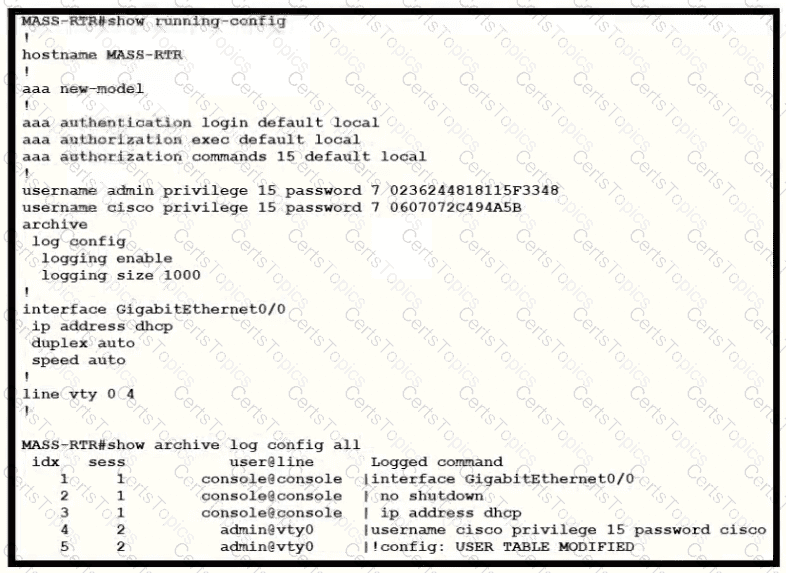
A client is concerned that passwords are visible when running this show archive log config all.
Which router configuration is needed to resolve this issue?
Which IGPs are supported by the MPLS LDP autoconfiguration feature?
In which two ways does the IPv6 First-Hop Security Binding Table operate? (Choose two.)
Refer to the exhibit.

A user has set up an IP SLA probe to test if a non-SLA host web server on IP address 10.1.1.1 accepts HTTP sessions prior to deployment. The probe is failing. Which action should the network administrator recommend for the probe to succeed?

Refer to the exhibit. A network administrator configured NTP on a Cisco router to get synchronized time for system and logs from a unified time source The configuration did not work as desired Which service must be enabled to resolve the issue?
An engineer configured a Cisco router to send reliable and encrypted notifications for any events to the management server. It was noticed that the notification messages are reliable but not encrypted. Which action resolves the issue?
Exhibit:

NTP is configured across the network infrastructure and Cisco DNA Center. An NTP issue was reported on the Cisco DNA Center at 17:15. Which action resolves the issue?
Refer to the exhibit.

AS65510 iBGP is configured for directly connected neighbors. R4 cannot ping or traceroute network 192 168.100.0/24 Which action resolves this issue?
Which feature drops packets if the source address is not found in the snooping table?
Refer to the exhibit.

While troubleshooting an EIGRP neighbor adjacency problem, the network engineer notices that the interface connected to the neighboring router is not participating in the EIGRP process. Which action resolves the issues?
Drag and drop the MPLS concepts from the left onto the descriptions on the right.

Refer to the exhibit.

The network administrator can see the DHCP discovery packet in R1. but R2 is not replying to the DHCP request. The R1 related interface is configured with the DHCP helper address. If the PC is directly connected to the FaO/1 interface on R2, the DHCP server assigns as IP address from the DHCP pool to the PC. Which two commands resolve this issue? (Choose two.)
An engineer configured Reverse Path Forwarding on an interface and noticed that the routes are dropped when a route lookup fails on that interface for a prefix that is available in the routing table Which interface configuration resolves the issue?
Refer to the exhibit.

Which action resolves the failed authentication attempt to the router?


Refer to the exhibit. The Los Angeles and New York routers are receiving routes from Chicago but not from each other. Which configuration fixes the issue?
What are two functions of MPLS Layer 3 VPNs? (Choose two.)


Refer to the exhibit. R2 has two paths to reach 192.168.13.0/24. but traffic is sent only through R3. Which action allows traffic to use both paths?
Refer to Exhibit.

Which two configurations allow clients to get dynamic ip addresses assigned?
Refer to the exhibit.

BGP and EIGRP are mutually redistributed on R3, and EIGRP and OSPF are mutually redistributed on R1. Users report packet loss and interruption of service to applications hosted onthe 10.1.1.0724 prefix. An engineer tested the link from R3 to R4 with no packet loss present but has noticed frequent routing changes on R3 when running the debug ip route command. Which action stabilizes the service?
A customer reports to the support desk that they cannot print from their PC to the local printer id:401987778. Which tool must be used to diagnose the issue using Cisco DNA Center Assurance?

Refer to the exhibit. A network administrator redistributed the default static route into OSPF toward all internal routers to reach to Internet. Which set of commands restores reachability to the Internet by internal routers?
Refer to the exhibit.

A network administrator is discovering a Cisco Catalyst 9300 and a Cisco WLC 3504 in Cisco DNA Center. The Catalyst 9300 is added successfully However the WLC is showing [ error "uncontactable" when the administrator tries to add it in Cisco DNA Center. Which action discovers WLC in Cisco DNA Center successfully?

Refer to the exhibit. The network administrator configured the branch router for IPv6 on the E 0/0 interface The neighboring router is fully configured to meet requirements, but the neighbor relationship is not coming up. Which action fixes the problem on the branch router to bring the IPv6 neighbors up?
Refer to the exhibits.

A user on the 192.168.1.0/24 network can successfully ping 192.168.3.1, but the administrator cannot ping 192.168.3.1 from the LA router. Which set of configurations fixes the issue?
A)

B)

C)

D)

Exhibit:

An engineer configured R2 and R5 as route reflectors and noticed that not all routes are sent to R1 to advertise to the eBGP peers. Which iBGP routers must be configured as route reflectors to advertise all routes to restore reachability across all networks?
Refer to the exhibit.

A network administrator configured an IPv6 access list to allow TCP return frame only, but it is not working as expected. Which changes resolve this issue?

Refer to the exhibit.

To provide reachability to network 10.1.1.0 /24 from R5, the network administrator redistributes EIGRP into OSPF on R3 but notices that R4 is now taking a ........... path through R5 to reach 10.1.1.0/24 network. Which action fixes the issue while keeping the reachability from R5 to 10.1.1.0/24 network?
Refer to the exhibit.

The network administrator must mutually redistribute routes at the Chicago router to the LA and NewYork routers. The configuration of the Chicago router is this:

After the configuration, the LA router receives all the NewYork routes, but NewYork router does not receive any LA routes. Which set of configurations fixes the problem on the Chicago router?
A)

B)

C)

D)

Refer to the exhibit.

Which action resolves the adjacency issue?
Refer to the exhibit.

The network administrator configured redistribution on an ASBR to reach to all WAN networks but failed Which action resolves the issue?
How does an MPLS Layer 3 VPN function?
Refer to the exhibit.

R1 is connected with R2 via GigabitEthernet0/0, and R2 cannot ping R1. What action will fix the issue?

Refer to the exhibit. The remote server is failing to receive the NetFlow data Which action resolves the issue?
Exhibit:

Which action resolves the authentication problem?
What does the PE router convert the Ipv4 prefix to within an MPLS VPN?
Refer to the exhibit.


The administrator can see the traps for the failed login attempts, but cannot see the traps of successful login attempts. What command is needed to resolve the issue?
Refer to the exhibit.

A network administrator is using the DNA Assurance Dashboard panel to troubleshoot an OSPF adjacency that failed between Edge_NYC interface GigabitEthernet1/3 with Neighbor Edge_SNJ. The administrator observes that the neighborship is stuck in exstart state. How does the administrator fix this issue?
An engineer configured policy-based routing for a destination IP address that does not exist in the routing table. How is the packet treated through the policy for configuring the set ip default next-hop command?
What statement about route distinguishes in an MPLS network is true?

Refer to the exhibit. The OSPF neighbor relationship is not coming up What must be configured to restore OSPF neighbor adjacency?
Refer to the exhibit.

An engineer wanted to set a tag of 30 to route 10 1.80.65/32 but it failed How is the issue fixed?
Which two components are needed for a service provider to utilize the LVPN MPLS application? (Choose two.)
What is the minimum time gap required by the local system before putting a BFD control packet on the wire?

Refer to the exhibit. A network administrator configured mutual redistribution on R1 and R2 routers, which caused instability in the network. Which action resolves the issue?
Refer to the exhibit.

The neighbor relationship is not coming up Which two configurations bring the adjacency up? (Choose two)
Refer to Exhibit.

Traffic from the branch network should route through HQ R1 unless the path is unavailable. An engineer tests this functionality by shutting down interface on the BRANCH router toward HQ_R1 router but 192.168.20.0/24 is no longer reachable from the branch router. Which set of configurations resolves the issue?

Refer to the exhibit. The engineer configured and connected Router2 to Router1. The link came up but could not establish a Telnet connection to Router1 IPv6 address of 2001:DB8::1. Which configuration allows Router2 to establish a Telnet connection to Router1?
Refer to Exhibit.

A network administrator added one router in the Cisco DNA Center and checked its discovery and health from the Network Health Dashboard. The network administrator observed that the router is still showing up as unmonitored. What must be configured on the router to mount it in the Cisco DNA Center?
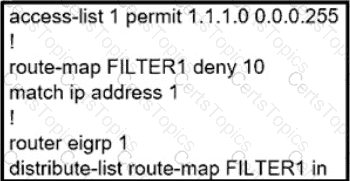
Refer to the exhibit. Which action restores the routes from neighbors while still filtering 1.1.1.0/24?
Refer to the exhibit.

PC-2 failed to establish a Telnet connection to the terminal server. Which configuration resolves the issue?

Clients on ALS2 receive IPv4 and IPv6 addresses but clients on ALS1 receive only IPv4 addresses and not IPv6 addresses. Which action on DSW1 allows clients on ALS1 to receive IPv6 addresses?

Refer to the exhibit.

A network administrator configured mutual redistribution on R1 and R2 routers, which caused instability in the network. Which action resolves the issue?
What does IPv6 Source Guard utilize to determine if IPv6 source addresses should be forwarded?
What are two functions of IPv6 Source Guard? (Choose two.)
An engineer configured access list NON-CISCO in a policy to influence routes

What are the two effects of this route map configuration? (Choose two.)
Refer to the exhibit.

SanFrancisco and Boston routers are choosing slower links to reach each other despite the direct links being up Which configuration fixes the issue?

Refer to the exhibit.


All the serial between R1, R2, and R3 have the Same bandwidth. User on the 192.168.1.0/24 network report slow response times while they access resource on network 192.168.3.0/24. When a traceroute is run on the path. It shows that the packet is getting forwarded via R2 to R3 although the link between R1 and R3 is still up. What must the network administrator to fix the slowness?

Refer to the exhibit. An engineer has successfully set up a floating static route from the BRANCH router to the HQ network using HQ_R1 as the primary default gateway When the g0/0 goes down on HQ_R1, the branch network cannot reach the HQ network 192.168.20.0/24. Which set of configurations resolves the issue?
Which two statements about VRF-Lite configurations are true? (Choose two.)
Drag and drop the operations from the left onto the locations where the operations are performed on the right.

Drag and drop the DHCP messages from the left onto the correct uses on the right.

Which transport layer protocol is used to form LDP sessions?
Drag and drop the SNMP attributes in Cisco IOS devices from the left onto the correct SNMPv2c or SNMPV3 categories on the right.

Refer to the exhibit.

Redistribution is enabled between the routing protocols, and nowPC2 PC3, and PC4 cannot reach PC1. What are the two solutions to fix the problem? (Choose two.)
Drag and drop the MPLS VPN device types from me left onto the definitions on the right.

Refer to the exhibit.

A network engineer for AS64512 must remove the inbound and outbound traffic from link A during maintenance without closing the BGP session so that there ............ a backup link over link A toward the ASN. Which BGP configuration on R1 accomplishes this goal?
A)

B)

C)

D)

What is an advantage of using BFD?
Refer to the exhibit.

The ACL is placed on the inbound Gigabit 0/1 interface of the router. Host
192.168.10.10cannot SSH to host 192.168.100.10 even though the flow is permitted. Which action
resolves the issue without opening full access to this router?
Which statement about IPv6 ND inspection is true?
Refer to the exhibit.

An administrator that is connected to the console does not see debug messages when
remote users log in. Which action ensures that debug messages are displayed for remote logins?
Which statement about route distinguishers in an MPLS network is true?
Which list defines the contents of an MPLS label?
Drag and drop the addresses from the left onto the correct IPv6 filter purposes on the right.

Refer to the exhibit.

Which configuration denies Telnet traffic to router 2 from 198A:0:200C::1/64?
A)

B)

C)

D)

What is a prerequisite for configuring BFD?
Refer to the exhibit.

The network administrator configured VRF lite for customer A. The technician at the remote site misconfigured VRF on the router. Which configuration will resolve connectivity for both sites of customer_a?

Refer to the exhibits.

Phase-3 tunnels cannot be established between spoke-to-spoke in DMVPN. Which two
commands are missing? (Choose two.)
Refer to the exhibit.

Users report that IP addresses cannot be acquired from the DHCP server. The DHCP
server is configured as shown. About 300 total nonconcurrent users are using this DHCP server, but none of them are active for more than two hours per day. Which action fixes the issue within the current resources?
Refer to the exhibit.
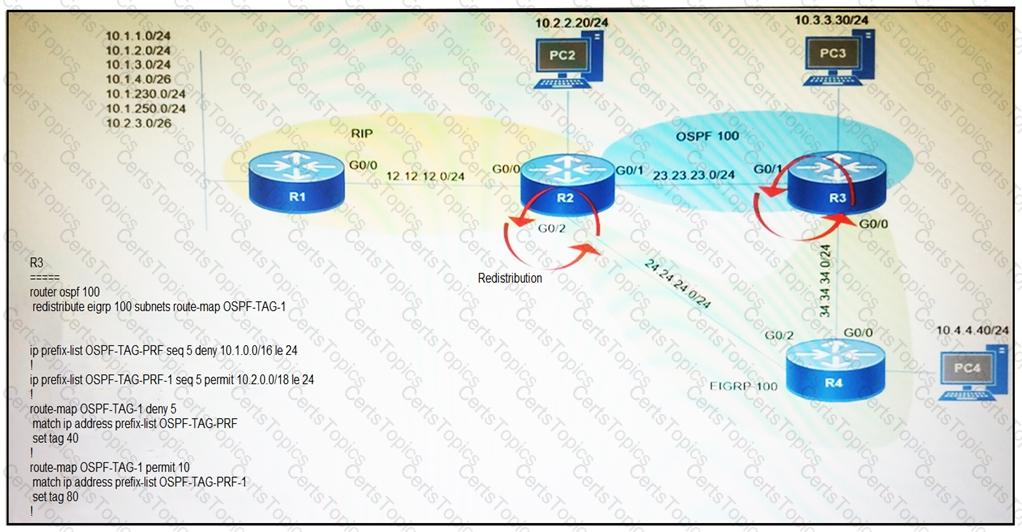
Which subnet is redistributed from EIGRP to OSPF routing protocols?
While working with software images, an engineer observes that Cisco DNA Center cannot upload its software image directly from the device. Why is the image not uploading?
Which protocol does VRF-Lite support?
An engineer is trying to copy an IOS file from one router to another router by using TFTP. Which two actions are needed to allow the file to copy? (Choose two.)
What is an advantage of using BFD?
Refer to the following output:
Router#show ip nhrp detail
10.1.1.2/8 via 10.2.1.2, Tunnel1 created 00:00:12, expire 01:59:47
TypE. dynamic, Flags: authoritative unique nat registered used
NBMA address: 10.12.1.2
What does the authoritative flag mean in regards to the NHRP information?
Refer to the exhibit.

Which statement about R1 is true?
Which attribute eliminates LFAs that belong to protected paths in situations where links in a network are connected through a common fiber?
An engineer configured a company’s multiple area OSPF head office router and Site A cisco
routers with VRF lite. Each site router is connected to a PE router of an MPLS backbone.

After finishing both site router configurations, none of the LSA 3,4 5, and 7 are installed at Site A router. Which configuration resolves this issue?
Refer to the exhibit.

An engineer configures a static route on a router, but when the engineer checks the route
to the destination, a different next hop is chosen. What is the reason for this?
What is a role of route distinguishers in an MPLS network?
Which statement about route distinguishers in an MPLS network is true?
Which two protocols can cause TCP starvation? (Choose two)
Refer to the exhibit.

Which interface configuration must be configured on the spoke A router to enable a dynamic DMVPN tunnel with the spoke B router?


An engineer configured a leak-map command to summarize EIGRP routes and advertise specifically loopback 0 with an IP of 10.1.1.1.255.255.255.252 along with the summary route. After finishing configuration, the customer complained not receiving summary route with specific loopback address. Which two configurations will fix it? (Choose two.)

Refer to the exhibit.

An engineer has configured DMVPN on a spoke router. What is the WAN IP address of another spoke router within the DMVPN network?
Refer to the exhibit.

What does the imp-null tag represent in the MPLS VPN cloud?
Refer to the exhibit.

Why is the remote NetFlow server failing to receive the NetFlow data?
Which command displays the IP routing table information that is associated with VRF-Lite?
Which statement about IPv6 ND inspection is true?
Which is statement about IPv6 inspection is true?
Which method changes the forwarding decision that a router makes without first changing the routing table or influencing the IP data plane?
Which statement about MPLS LDP router ID is true?
What is a limitation of IPv6 RA Guard?
Refer to the exhibit.

An engineer is trying to configure local authentication on the console line, but the device is trying to authenticate using TACACS+. Which action produces the desired configuration?
Which option is the best for protecting CPU utilization on a device?
Drag and drop the packet types from the left onto the correct descriptions on the right.

Refer to the exhibit.

An IP SLA is configured to use the backup default route when the primary is down, but it is not working as desired. Which command fixes the issue?
An engineer configured a leak-map command to summarize EIGRP routes and advertise specifically loopback 0 with an IP of 10.1.1.1.255.255.255.252 along with the summary route. After finishing configuration, the customer complained not receiving summary route with specific loopback address. Which two configurations will fix it? (Choose two.)

Refer to the exhibit.

An engineer is trying to block the route to 192.168.2.2 from the routing table by using the
configuration that is shown. The route is still present in the routing table as an OSPF route. Which action blocks the route?
Refer to the exhibit.

Users in the branch network of 2001:db8:0:4::/64 report that they cannot access the Internet. Which command is issued in IPv6 router EIGRP 100 configuration mode to solve this issue?

Refer to the exhibit. an engineer is trying to get 192.168.32.100 forwarded through 10.1.1.1, but it was forwarded through 10.1.1.2. What action forwards the packets through 10.1.1.1?
Which statement about IPv6 RA Guard is true?
Which statement about MPLS LDP router ID is true?
Refer to the exhibit.

The output of the trace route from R5 shows a loop in the network. Which configuration
prevents this loop?
A)

B)

C)

D)

Drag and drop the operations from the left onto the locations where the operations are performed on the right.

When provisioning a device in Cisco DNA Center, the engineer sees the error message “Cannot select the device. Not compatible with template”.
What is the reason for the error?
Refer to the exhibit.

Which configuration configures a policy on R1 to forward any traffic that is sourced from
the 192.168.130.0/24 network to R2?


Which two statements about redistributing EIGRP into OSPF are true? (Choose two)
A network engineer needs to verify IP SLA operations on an interface that shows on indication of
excessive traffic.
Which command should the engineer use to complete this action?
Which command is used to check IP SLA when an interface is suspected to receive lots of traffic with options?
Which protocol does MPLS use to support traffic engineering?
Which command allows traffic to load-balance in an MPLS Layer 3 VPN configuration?